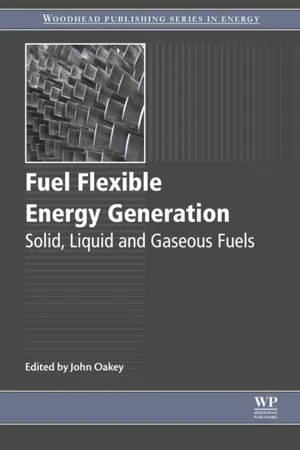
- 334 pages
- English
- ePUB (mobile friendly)
- Available on iOS & Android
About this book
Fuel Flexible Energy Generation: Solid, Liquid and Gaseous Fuels provides updated information on flexible fuel energy generation, the process by which one or more fuels can be combusted in the same boiler or turbine to generate power. By adapting or building boilers and turbines to accept multiple fuel sources, they can be co-fired with biomass and waste derived fuels, allowing a reduction in carbon output, thus providing cleaner energy.Fuel flexibility is becoming more important in a world of diminishing fossil fuel stocks. Many countries are investing in the development of more efficient fuel flexible boilers and turbines, and their use is becoming more prevalent in industry as well.This book provides comprehensive coverage of flexible fuel energy generation across all potential fuel types, and was written by a selection of experts in the field who discuss the types of fuels which can be used in fuel flexible energy generation, from solid fuels to biomass fuels, the preparation of fuels to be used in fuel flexible operations, that includes their handling and transport, and combustion and conversion technologies with chapters ranging from large-scale coal gasification to technology options and plant design issues.- Focuses on fuel flexibility across all potential fuel types- Includes thorough treatment of the technology being developed to allow for fuel flexibility- Written by leading experts in the field- Provides an essential text for R&D managers in firms which produce boilers or turbines, those who work in the fuel industry, and academics working in engineering departments on energy generation
Frequently asked questions
- Essential is ideal for learners and professionals who enjoy exploring a wide range of subjects. Access the Essential Library with 800,000+ trusted titles and best-sellers across business, personal growth, and the humanities. Includes unlimited reading time and Standard Read Aloud voice.
- Complete: Perfect for advanced learners and researchers needing full, unrestricted access. Unlock 1.4M+ books across hundreds of subjects, including academic and specialized titles. The Complete Plan also includes advanced features like Premium Read Aloud and Research Assistant.
Please note we cannot support devices running on iOS 13 and Android 7 or earlier. Learn more about using the app.
Information
Introduction to fuel flexible energy
Abstract
Keywords
Biomass; Coal; Natural gas; Oil from shale; Oil shale; Petroleum; Shale gas; Tar sand bitumen1.1. Introduction
Table of contents
- Cover image
- Title page
- Table of Contents
- Related titles
- Copyright
- List of contributors
- Woodhead Publishing Series in Energy
- Part One. Introduction and fuel types
- Part Two. Fuel preparation, handling and transport
- Part Three. Combustion and conversion technologies
- Index